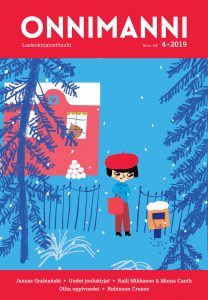
In the editorial, Onnimanni’s chief editor wishes that the marketing of children’s and YA-books would no longer rely on rigid ideas of age- and target-groups. Literacy is no longer mastered at a certain age or school-level. High-quality picture books raising fundamental existential issues are suitable also when teaching secondary school and high school students e.g. multiliteracy.
Sisko Ylimartimo presents the forgotten Polish illustrator Janusz Grabiański (1929–1976). With only two colours, Grabiański was able to create an illusion of multicolour. Ylimartimo also demonstrates his use of intervisual references to pay tribute to past cultural images.
Tuula Korolainen has read the latest Christmas-themed children’s books, which keep focusing on snow, gifts, helpfulness and friendship. The new books still struggle with preserving children’s belief in Santa Clause.
The narrator of Raili Mikkanen’s latest historical YA-novel is Elli, the teenage daughter of Finland’s first significant woman writer Minna Canth (1844–1897). Mikkanen’s historical novels often demand extensive background research. In Marjo Jääskä’s interview, she reveals that information is so much easier to find today on the internet.
Anni Swan (1875–1958) published her preteen-novel Ollin oppivuodet (1919) a hundred years ago. Tuula Korolainen has re-read the classic and found that – subtly updated – it would be of interest for today’s young readers.anni S
In Germany, sixth graders compete in reading aloud and have done so for a long time. Kaisa Lange has judged these competitions and found that pupils compete increasingly often in order to learn about literature and enhance their communication skills.
Daniel Defoe’s classic Robinson Crusoe was published 300 years ago. To celebrate the occasion, British publisher Thames & Hudson has issued the book Archipelago: An Atlas of Imagined Islands, in which illustrators worldwide have created their own island landscapes. Finnish illustrators participating in the book are Linda Bondestam, Matti Pikkujämsä and Réka Király.
The established Finnish publishers’ range of children’s and YA-books is limited to titles that will sell. In protest, a group of distinguished authors have founded the VaLas-collective, which will support the publication of experimental, rather than commercial works.
The reading promotion society Kirjavinkkariyhdistys has won the Institute’s Onnimanni Prize for its long-term and unwavering grass root work. The manuscript Be Cool – co-written by Matilda Ahlsten, Saara Honkanen and Suvi Nurmi – has won the Institute and publisher Karisto’s writing competition, which looked for texts of interest to 11–14-year-old boys.
In the Lukutikku-column addressed to professional educators, Juli-Anna Aerila presents “reading corners” initiated by Indian editor Arundhati Deosthale. Aerila also presents new material on how to support multilingual and -cultural children.
Onnimanni introduces a new column called The Compass (Kompassi), which will feature topical debates. Illustrator Jani Ikonen addresses the role of illustration in children’s literature, arguing that illustrations are readable pictures and that exploring visual art can be part of an illustrator’s task.
Translation Maria Lassén-Seger
